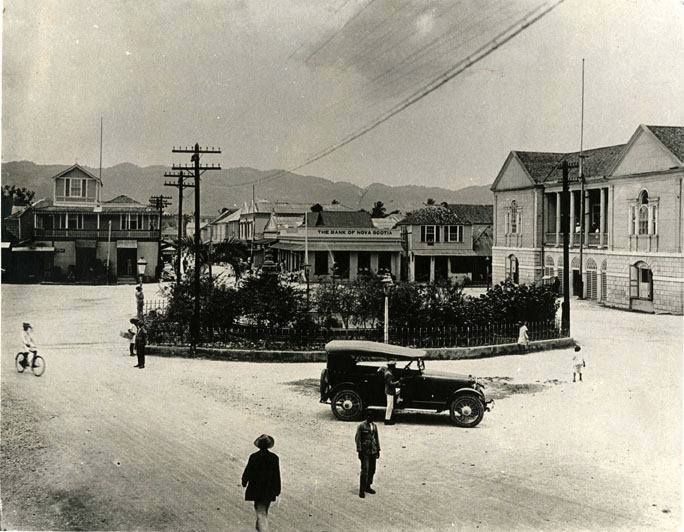The Spaniards who began occupying Jamaica in 1509 under license named the area that is now Montego Bay, “Bahia de Manteca,” due to its significance in lard production.
Sir Hans Sloane, Anglo-Irish physician, naturalist, and collector who bequeathed his vast collection to the British nation, leading to the establishment of the British Museum in 1759, noted that boiling swine’s flesh into lard was the primary commerce in Montego Bay during its early history.
The National Library of Jamaica elaborates, “The region now known as Montego Bay had a dense population of wild hogs which the Spanish were said to have slaughtered in large numbers in order to collect hog’s butter (lard) for export to Cartagena.”
British rule
Montego Bay began to evolve under British rule. By the late 19th century, Montego Bay had become the second most important town in Jamaica in terms of size, population, and commerce. It was a major trading center, with significant import and export duties.
The harbor at Montego Bay, an open roadstead, was generally safe for ships during normal land and sea breezes. However, it could be dangerous between November and March when strong winds known as “northers” blew in from the north, bringing heavy seas. Ships sometimes required a second anchor during these periods, and accidents were known to occur.
Several key developments occurred in Montego Bay during the late 19th century. The filling in of a swamp near the town’s creek, which had been a long-standing health hazard, was a significant improvement. The opening of a large, well-designed market provided a central place for commerce. Additionally, the establishment of regular steamship service to the United States enhanced trade and connectivity.

Montego Bay saw the development of key infrastructure and amenities in the 19th and 20th centuries. These included a courthouse, an Episcopal church and Trinity Chapel, chapels for the Wesleyan, Baptist, and Presbyterian denominations, a Custom House, and old military barracks that were later used as a police station. The town also developed a water supply system, electricity, an ice factory, and a telephone system.
Sea-bathing was a popular activity in Montego Bay, with residents boasting that Doctor’s Cave and the White Sands offered the finest bathing spots on the island. The development of a railway line connecting Montego Bay to Kingston in 1895 further enhanced its importance as a commercial and tourist hub.
The main agricultural products of the parish surrounding Montego Bay were sugar, rum, and coffee. The fruit trade, particularly bananas, also became increasingly important. This agricultural prosperity contributed significantly to the town’s economic growth and development.
By the early 20th century, Montego Bay had become a significant center for the fruit trade, which not only made previously unproductive land valuable but also provided jobs for people who needed them.
Major occurrences
The Great Hurricane of 1780 caused widespread destruction in Montego Bay and other parts of Jamaica, significantly impacting the region’s economy and population.
Perhaps the most important occurrence in Montego Bay’s history was the Sam Sharpe Rebellion in 1831-32, which began on estates in St. James and sparked widespread conflagration across the island. Its impact went far beyond Jamaica, purportedly hastening the end of the despised system of slavery before the end of the decade.
In April 1963, attempts to evict Rastafarians from lands slated for hotel and tourism development in Coral Gardens led to violent altercations between Rastafarians and the police sent to enforce the evictions. Several people were killed, while others were arrested, detained, and some tortured. The state’s repression spread to Rastafarian communities elsewhere in Jamaica, continuing into July of that year. Tensions had been brewing for years. A state of emergency was declared in 1960, and several Rastafarians were executed for allegedly plotting with communist Cuba against the Jamaican government.
Tourist mecca
Montego Bay has solidified its position as one of the Caribbean’s premier destinations as the tourism industry remains the backbone of its economy. All-inclusive resorts, boutique hotels, and luxury villas have sprung up along the coastline, catering to a diverse range of travelers. The city’s golf courses, water sports, and shopping opportunities further enhance its appeal.
To accommodate the growing number of tourists, significant investments have been made in infrastructure development. The Sangster International Airport has undergone several expansions and modernizations, making it one of the busiest airports in the Caribbean. Improved roads and transportation systems have facilitated easier access to the city and its surrounding attractions.
Montego Bay has also embraced its historical heritage. Efforts have been made to preserve historic sites and landmarks, such as Fort Montego and Rose Hall Great House. These sites offer visitors a glimpse into the island’s colonial past and the lives of its former inhabitants.
While Montego Bay has experienced significant growth and prosperity, it has also faced challenges such as environmental concerns, crime, and economic inequality. There have been attempts to address these issues, including implementing sustainable tourism practices, strengthening law enforcement, and investing in social programs.
